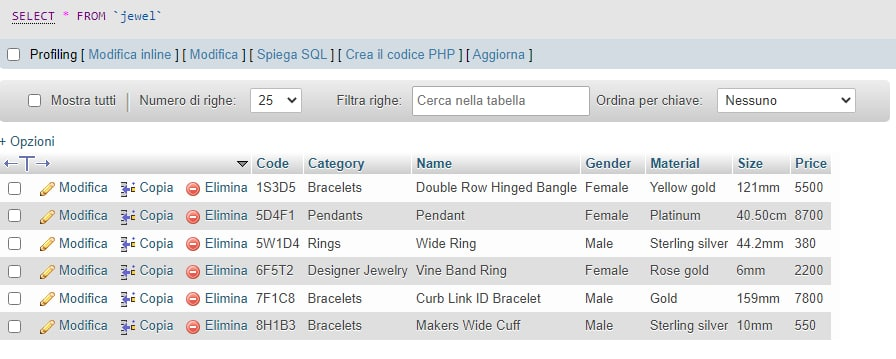I have a problem. I don't understand clearly the code. I have a similar problem with my code.
I have created database SQL and filled up. Then I want to implement a MainServlet (code below) that richieve data from database and in a different jsp page, I want to insert that data in section like h1, h2 ecc... I must use the ${} sintax but I don't know how do that.
Briefly, In jsp file (code below, I MUST USE ${} SINTAX) I want to "call" MainServlet and there I want to richieve data from database and view in jsp file.
I hope I have explained correctly, thank you very much!
MainServlet.java
import java.io.IOException;
import java.sql.Connection;
import java.sql.DriverManager;
import java.sql.ResultSet;
import java.sql.SQLException;
import java.sql.Statement;
import javax.servlet.ServletConfig;
import javax.servlet.ServletException;
import javax.servlet.annotation.WebServlet;
import javax.servlet.http.HttpServlet;
import javax.servlet.http.HttpServletRequest;
import javax.servlet.http.HttpServletResponse;
/**
* Servlet implementation class MainServlet
*/
@WebServlet({ "/MainServlet" })
public class MainServlet extends HttpServlet {
private static final long serialVersionUID = 1L;
private static final String PATH_JSP = "/WEB-INF/";
/**
* @see HttpServlet#HttpServlet()
*/
public MainServlet() {
super();
// TODO Auto-generated constructor stub
}
/**
* @see Servlet#init(ServletConfig)
*/
public void init(ServletConfig config) throws ServletException {
// TODO Auto-generated method stub
}
/**
* @see Servlet#destroy()
*/
public void destroy() {
// TODO Auto-generated method stub
}
/**
* @see HttpServlet#doGet(HttpServletRequest request, HttpServletResponse response)
*/
protected void doGet(HttpServletRequest request, HttpServletResponse response) throws ServletException, IOException {
String doveAndare = request.getParameter("azione");
if(doveAndare==null)
doveAndare = "index";
try {
String driverString = "com.mysql.cj.jdbc.Driver";
Class.forName(driverString);
String connString = "jdbc:mysql://localhost:3306/ldd_jewels?user=root&password=";
Connection conn = DriverManager.getConnection(connString);
Statement stmt = conn.createStatement();
ResultSet rs = stmt.executeQuery("SELECT * FROM JEWEL");
while (rs.next() == true) {
System.out.println(rs.getString("Category") + "\t" + rs.getString("Name"));
/* I try that but does not work
request.setAttribute("name", rs.getString("Name"));
javax.servlet.RequestDispatcher dispatcher = request.getRequestDispatcher("/WEB-INF/widering_male.jsp");
dispatcher.forward(request, response); */
}
stmt.close();
conn.close();
} catch(Exception e) {
e.printStackTrace();
}
request.getRequestDispatcher(PATH_JSP+doveAndare+".jsp").forward(request, response);
}
/**
* @see HttpServlet#doPost(HttpServletRequest request, HttpServletResponse response)
*/
protected void doPost(HttpServletRequest request, HttpServletResponse response) throws ServletException, IOException {
// TODO Auto-generated method stub
doGet(request, response);
}
}
doublerow.jsp
<section id="portfolio-details" class="portfolio-details">
<div class="container">
<div class="row gy-4">
<div class="col-lg-8">
<div class="portfolio-details-slider swiper">
<div class="swiper-wrapper align-items-center">
<div class="swiper-slide">
<img src="assets/img/jewels/doublerow_1.jpg" alt="" />
</div>
<div class="swiper-slide">
<img src="assets/img/jewels/doublerow_2.jpg" alt="" />
</div>
<div class="swiper-slide">
<img src="assets/img/jewels/doublerow_3.jpg" alt="" />
</div>
</div>
<div class="swiper-pagination"></div>
</div>
</div>
<div class="col-lg-4">
<div class="portfolio-info">
<h3>Product details</h3>
<ul>
<li><strong>Code</strong>: 1S3D5</li>
<li><strong>Category</strong>: Bracelets</li>
<li><strong>Name</strong>: Double Row Hinged Bangle</li>
<li><strong>Gender</strong>: Female</li>
<li><strong>Material</strong>: Yellow gold</li>
<li><strong>Size</strong>: 121mm</li>
<li><strong>Price</strong>: €5500</li>
</ul>
</div>
<div class="portfolio-description">
<h2>Description of product</h2>
<p>
The entwined ends of Tiffany Knot’s signature motif symbolize
the power of connections between people. Balancing strength
and elegance, each Tiffany Knot design is a complex feat of
craftsmanship. This bangle is crafted with yellow gold and
polished by hand for high shine. Wear on its own or partnered
with classic silhouettes for an unexpected pairing.
</p>
</div>
</div>
</div>
</div>
</section>
This is my database:
![Database]() I want to insert each jewel in different pages (each jewel have a jsp file)
I want to insert each jewel in different pages (each jewel have a jsp file)

